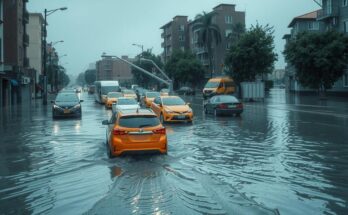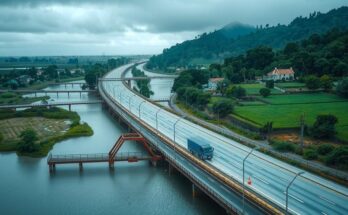Experts express concerns about potential water scarcity in Greater São Paulo due to climate change despite current favorable water reservoir conditions. Observations of erratic rainfall and increased temperatures highlight the need for careful management and infrastructural improvements. Proactive measures including enhanced water transfer projects and reforestation are proposed to ensure future water security.
In São Paulo, although reservoir levels are currently at satisfactory levels, experts express concern about the city’s water security due to climate change. The increasing frequency of heatwaves and erratic rainfall patterns underscore the need for strategic actions to secure long-term water supplies. José Marengo of Cemaden highlights a growing risk of water scarcity in Greater São Paulo, necessitating heightened monitoring and efficiency in water management.
Despite the ample current reservoir levels, Samuel Barreto from The Nature Conservancy illustrates a decline from last year’s averages, asserting that rainfall has not met historical expectations since last October. This pattern signifies a shift to intense storm bursts rather than regular precipitation, resulting in significant challenges, including wildfires, according to Mr. Marengo.
The Greater São Paulo area, home to over 20 million residents and relying on seven primary water supply systems, is facing critical changes in its climate patterns. Ana Paula Cunha from Cemaden notes that while summer rains might create an illusion of adequate rainfall, the reality indicates a concentration of precipitation over fewer days, which raises the risk of severe flooding and water scarcity.
Samanta Souza from Sabesp, the local water utility, indicates that the current situation remains stable, with high water security measures in place. The former head of ANA, Jerson Kelman, asserts that engineering advancements since the last water crisis have significantly improved water distribution and resilience, alleviating past vulnerabilities.
Focusing on proactive measures, Mr. Marengo urges for an overhaul in the water transport system to mitigate waste due to failing infrastructure. The impact of climate change due to greenhouse gas emissions remains a stark reality, as emphasized by Ms. Cunha, who warns that the effects are irreversible in the long-term.
In response to the ongoing water challenges, Sabesp is implementing plans for enhancing water collection and distribution, including projects to channel raw water from the Itapanhaú River. The municipal government is also working on a new sanitation plan, anticipating improvements in areas affected by previous water crises.
Experts like Mr. Barreto advocate for more comprehensive strategies to address climate impacts, suggesting the need for resilience building and infrastructural adaptations to meet increasing temperatures and erratic rainfall. Reforestation of watersheds is proposed as a viable solution to enhance water quality and reduce mitigation costs, with initiatives already in progress to restore native vegetation across critical areas.
In summary, Greater São Paulo faces a potentially precarious water future due to climate variability, underscoring the urgent need for strategic planning and comprehensive management of water resources. While current reservoir levels are stabilized, experts stress the importance of tackling infrastructure issues and embracing sustainable practices, such as reforestation. Collaborative efforts between local governments and water authorities are essential to ensure long-term resilience amid ongoing climate challenges.
Original Source: valorinternational.globo.com




